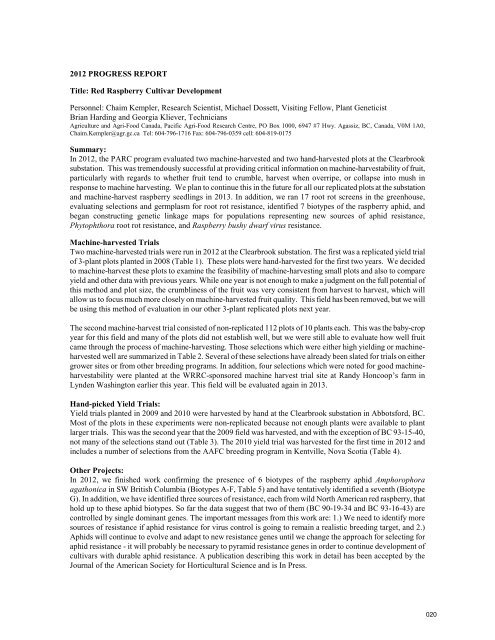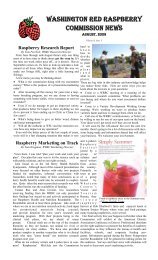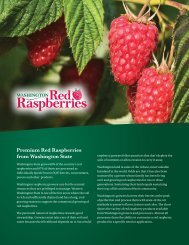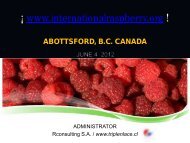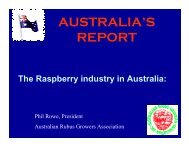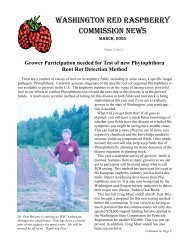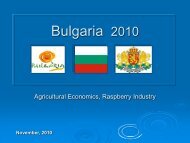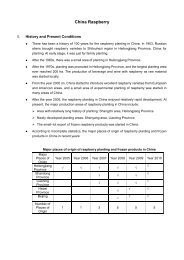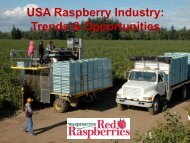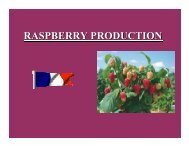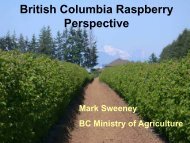2012 - Washington Red Raspberry Commission
2012 - Washington Red Raspberry Commission
2012 - Washington Red Raspberry Commission
You also want an ePaper? Increase the reach of your titles
YUMPU automatically turns print PDFs into web optimized ePapers that Google loves.
<strong>2012</strong> PROGRESS REPORT<br />
Title: <strong>Red</strong> <strong>Raspberry</strong> Cultivar Development<br />
Personnel: Chaim Kempler, Research Scientist, Michael Dossett, Visiting Fellow, Plant Geneticist<br />
Brian Harding and Georgia Kliever, Technicians<br />
Agriculture and Agri-Food Canada, Pacific Agri-Food Research Centre, PO Box 1000, 6947 #7 Hwy. Agassiz, BC, Canada, V0M 1A0,<br />
Chaim.Kempler@agr.gc.ca Tel: 604-796-1716 Fax: 604-796-0359 cell: 604-819-0175<br />
Summary:<br />
In <strong>2012</strong>, the PARC program evaluated two machine-harvested and two hand-harvested plots at the Clearbrook<br />
substation. This was tremendously successful at providing critical information on machine-harvestability of fruit,<br />
particularly with regards to whether fruit tend to crumble, harvest when overripe, or collapse into mush in<br />
response to machine harvesting. We plan to continue this in the future for all our replicated plots at the substation<br />
and machine-harvest raspberry seedlings in 2013. In addition, we ran 17 root rot screens in the greenhouse,<br />
evaluating selections and germplasm for root rot resistance, identified 7 biotypes of the raspberry aphid, and<br />
began constructing genetic linkage maps for populations representing new sources of aphid resistance,<br />
Phytophthora root rot resistance, and <strong>Raspberry</strong> bushy dwarf virus resistance.<br />
Machine-harvested Trials<br />
Two machine-harvested trials were run in <strong>2012</strong> at the Clearbrook substation. The first was a replicated yield trial<br />
of 3-plant plots planted in 2008 (Table 1). These plots were hand-harvested for the first two years. We decided<br />
to machine-harvest these plots to examine the feasibility of machine-harvesting small plots and also to compare<br />
yield and other data with previous years. While one year is not enough to make a judgment on the full potential of<br />
this method and plot size, the crumbliness of the fruit was very consistent from harvest to harvest, which will<br />
allow us to focus much more closely on machine-harvested fruit quality. This field has been removed, but we will<br />
be using this method of evaluation in our other 3-plant replicated plots next year.<br />
The second machine-harvest trial consisted of non-replicated 112 plots of 10 plants each. This was the baby-crop<br />
year for this field and many of the plots did not establish well, but we were still able to evaluate how well fruit<br />
came through the process of machine-harvesting. Those selections which were either high yielding or machineharvested<br />
well are summarized in Table 2. Several of these selections have already been slated for trials on either<br />
grower sites or from other breeding programs. In addition, four selections which were noted for good machineharvestability<br />
were planted at the WRRC-sponsored machine harvest trial site at Randy Honcoop’s farm in<br />
Lynden <strong>Washington</strong> earlier this year. This field will be evaluated again in 2013.<br />
Hand-picked Yield Trials:<br />
Yield trials planted in 2009 and 2010 were harvested by hand at the Clearbrook substation in Abbotsford, BC.<br />
Most of the plots in these experiments were non-replicated because not enough plants were available to plant<br />
larger trials. This was the second year that the 2009 field was harvested, and with the exception of BC 93-15-40,<br />
not many of the selections stand out (Table 3). The 2010 yield trial was harvested for the first time in <strong>2012</strong> and<br />
includes a number of selections from the AAFC breeding program in Kentville, Nova Scotia (Table 4).<br />
Other Projects:<br />
In <strong>2012</strong>, we finished work confirming the presence of 6 biotypes of the raspberry aphid Amphorophora<br />
agathonica in SW British Columbia (Biotypes A-F, Table 5) and have tentatively identified a seventh (Biotype<br />
G). In addition, we have identified three sources of resistance, each from wild North American red raspberry, that<br />
hold up to these aphid biotypes. So far the data suggest that two of them (BC 90-19-34 and BC 93-16-43) are<br />
controlled by single dominant genes. The important messages from this work are: 1.) We need to identify more<br />
sources of resistance if aphid resistance for virus control is going to remain a realistic breeding target, and 2.)<br />
Aphids will continue to evolve and adapt to new resistance genes until we change the approach for selecting for<br />
aphid resistance - it will probably be necessary to pyramid resistance genes in order to continue development of<br />
cultivars with durable aphid resistance. A publication describing this work in detail has been accepted by the<br />
Journal of the American Society for Horticultural Science and is In Press.<br />
020


